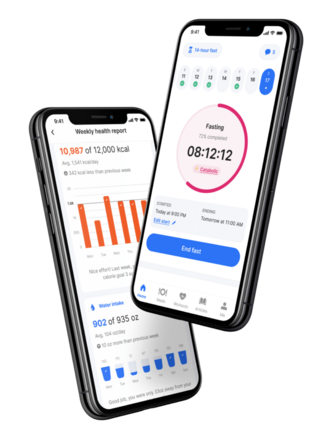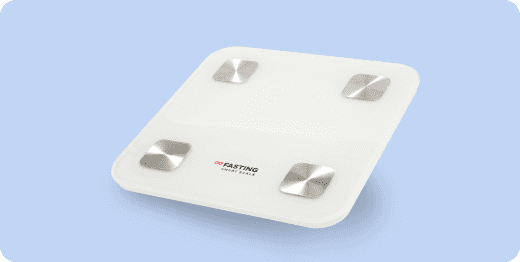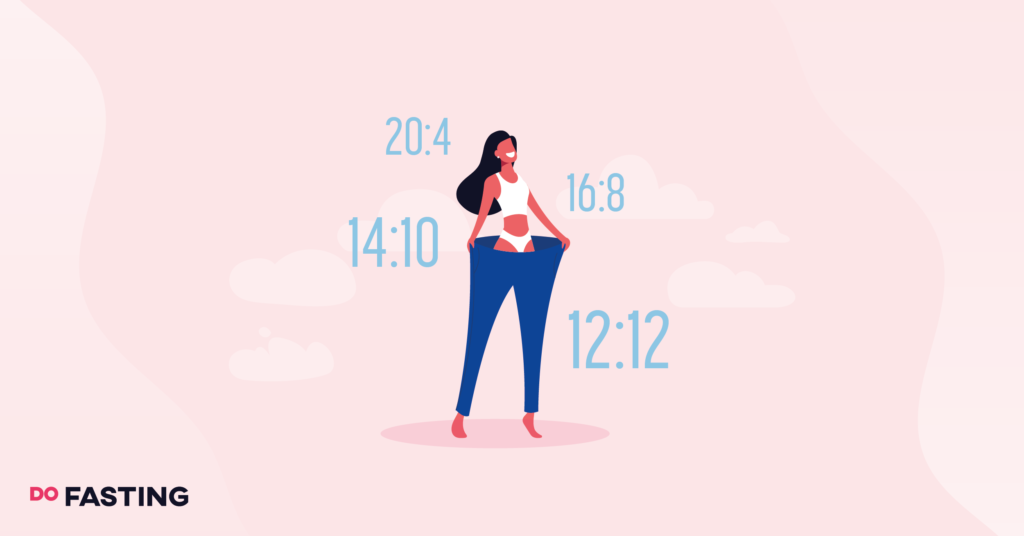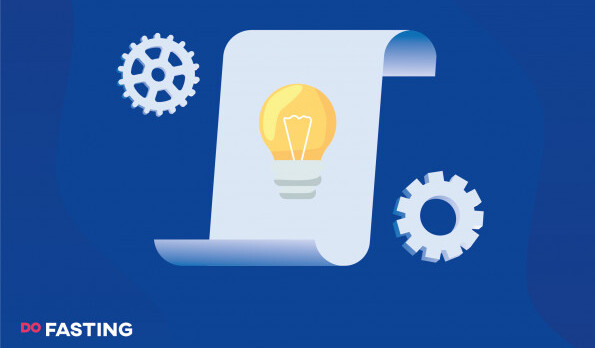Contents
-
12:12 Fast
The 12:12 Fast is usually considered a beginner fasting plan because of its relative ease and the fact that most of the fasting window is spent during sleeping hours.
In a 12:12 fast, you eat for 12 hours a day and then fast for the other 12 hours. This means that you would eat between 7 am and 7 pm, then not eat again until you eat breakfast at 7 am the next morning.
The hours can change to suit your needs, but the time-restricted eating must be adhered to.
During the eating period on a 12:12 fast, you may eat as you wish, though the best results are seen when you eat whole and healthy foods during the eating period to maintain a calorie restriction.
The 12:12 diet helps to reduce calorie intake and provides a long enough fasting period for the metabolic switch into ketosis. Ketosis usually begins after 10 – 12 hours of fasting.
This state, caused by prolonged fasting, allows the body to burn body fat as fuel and is designed to keep our bodies moving when food is scarce.
The 12:12 diet is a great way to kick off a weight loss journey and is also thought to improve brain health, reduce inflammation in the body, lengthen life expectancy by boosting autophagy, and enhance the body’s natural detoxification process.
Take a
1-minute quiz
and discover how much weight you can lose with DoFasting!

-
14:10 Fast
The 14:10 Fast eating plan is a popular method of intermittent fasting and involves fasting for 14 hours and then eating normally for 10 hours.
Slightly more advanced than the 12:12 method, this intermittent fasting plan usually means eating between 9 am and 7 pm and then not eating again until 9 am the next morning.
This method allows no calories to be consumed during the fasting period and the best results are produced when the food eaten during the eating window is healthy and whole.
The 14:10 method is a good choice for people who like to eat breakfast as it allows time for all three meals in the day, even if you may end up eating an early dinner.
This is also a good choice for people who have busier schedules and may not be able to incorporate extended periods of fasting into their day. This fasting period is sufficient to produce a state of ketosis.
You may also try the 14:10 method if you are building up to more advanced and difficult intermittent fasting plans as you are able to get your body used to fasting.
Th 14:10 method is unlikely to cause any of the commonly experienced side effects of fasting, like headaches, fatigue, and hunger pangs as it allows normal eating for 10 hours a day.
This intermittent fasting method can help to boost weight loss, improve your quality of sleep, and help you to eat a reduced calorie intake.
-
16:8 Fast
The 16:8 Fast is probably the most commonly followed intermittent fasting schedule because of its renowned ability to boost significant weight loss.
To follow this method, most people usually eat between 12 pm and 8 pm and then fast until 12 pm the next day, eating normally in the eight hour window and then stopping eating after your evening meal.
This method provides extended periods of fasting inducing ketosis, the state that allows body fat to be burned for fuel instead of blood sugar, helping you to lose body fat.
This method increases autophagy, the process by which cells recycle themselves, and boosts life expectancy.
It also helps in preventing type 2 diabetes as it helps with blood sugar control and insulin resistance.
Other benefits of the 16:8 method include a reduction in oxidative stress, improved cardiovascular and cognitive health, and increased fat loss.
The 16:8 method is good for keeping weight off because of the reduced eating time. This shorter eating window means fewer calories can be eaten throughout the day.
It is also thought to decrease your appetite after a few weeks of using this method, which can help with hunger pangs, cravings for certain foods, and overeating.
-
18:6 Fast
The 18:6 Fast is a step up from the 16:8 fasting method and can be used as a continuous eating schedule but if you’re starting out, it’s recommended to practice once or twice a week.
This method involves eating for 6 hours and fasting for 18 hours.
You could begin your eating period at 12 pm, like the 16:8 method, but stop eating at 6 pm, have an early dinner, and fast through until midday the next day.
This method of intermittent fasting is a really good method of reducing your food intake throughout the day. With a shorter eating window, it is difficult to overeat.
The 18:6 schedule benefits your body in a few ways. It increases HGH levels which helps you to burn fat and grow muscle and reduces insulin levels to help the body burn stored fats.
Other benefits of the 18:6 method include boosting your metabolic health, reducing inflammation, lowering the risk of diabetes, reducing the risk of cardiovascular diseases, and possibly reducing your risk of developing cancer.
Take a
1-minute quiz
and discover how much weight you can lose with DoFasting!

-
20:4 Fast aka “The Warrior diet”
The 20:4 Fast, or the Warrior Diet, is a method of fasting reminiscent of the way warriors used to eat. The idea is that you eat very little during the day and then ‘feast’ in the evening.
The method involves a 20-hour fasting window and a 4-hour ‘feasting’ window. Though the idea is that you feast in the evening when you eat dinner, you may choose to have your eating period whenever you wish on this diet.
The reason many intermittent fasting enthusiasts follow this diet is because of the relative freedom of what you can eat in the regular eating window.
Even though you are allowed to eat what you would like, the best results of intermittent fasting always come when the food that is eaten during the eating period is clean and healthy, and includes lots of fruits, vegetables, whole grains and healthy fats.
This method of intermittent fasting is known to be hugely beneficial for weight loss but it also comes with other health benefits too.
Health benefits include improved blood sugar control, lowered blood pressure, improvement in brain health, and a reduction in inflammation.
This diet may be easier to stick to because you don’t have to give up foods that you love in the eating window.
-
OMAD (One Meal a Day)
The OMAD method of intermittent fasting, or One Meal A Day, is one of the most advanced and restrictive intermittent fasting patterns you can try.
The method involves eating just one meal a day and is considered the 23:1 method of intermittent fasting. The OMAD Method is great for significantly restricting calories and has been shown to induce healthy weight loss in those who follow the diet.
As with the 20:4 method, you can eat whatever you would like during your one meal, though it is best to stick to whole and healthy foods.
As you will only be eating one meal, it is important that you get in as many macro and micro nutrients as possible so you do not become deficient. This method of fasting helps to reduce insulin spikes, helping the body to regulate blood sugar well. It also induces autophagy.
The One Meal A Day method is an accessible choice for intermittent fasting because the meal can be eaten at any point during the day. This means those with hectic lives can choose when it suits them to eat.
Although it can be eaten whenever, there is some evidence that eating at the same time each day helps improve weight loss. The One Meal A Day Method may come with some side effects which include fatigue and dizziness.
If you’re planning on trying out this method of intermittent fasting, it may be a good idea to start with an easier option and build your way up so that you get used to longer fasting periods first.
-
Random meal skipping
The random meal skipping method of intermittent fasting is a much more intuitive method of fasting and is centered around your own hunger needs.
The idea is that you skip meals when you feel like it while eating unprocessed, whole, and healthy foods at all times.
It is an incredibly flexible method of intermittent fasting and is a good choice for anyone who does not have the time to commit to a more advanced kind of intermittent fasting.
When following a random meal skipping fasting method, you may choose to skip lunch one day when you have had a bigger breakfast but skip dinner the next. It is wholly based on how you feel.
This method helps to reduce your caloric intake but isn’t as restrictive as other versions of intermittent fasting.
-
5:2 diet
The 5:2 diet is a little different from the already discussed methods of fasting because it refers to fasting across days rather than in one day.
The 5:2 method means you eat normally for five days and then restrict your caloric intake for the other two. The restricted days allow no more than 500 – 600 calories and should be taken with an eating day in between.
During the non-fasting days, you should eat a whole and balanced diet to see the best results.
On fasting days, you may choose to eat one meal of 500 – 600 calories, or you may split the calories in two. It is important you count calories consumed on fasting days.
It is essential that you do not engage in strenuous physical activity on your fasting days as you may become exhausted more quickly.
The 5:2 method is relatively flexible as you can take the fasting days whenever you please, though it is highly recommended that you break your fasting days up by at least one day.
This method is a good choice if you have found complete fasting difficult as you are allowed to eat some during your fasting days.
-
Alternate-day fasting
Alternate-day fasting is a time-restricted method of fasting wherein you fast for one day and then eat normally the next, stopping eating again to fast after your last meal of the day.
Similar to the 5:2 method of fasting, you would be allowed to eat a restricted number of calories (500 calories) on the fasting days, which can be split up into two meals if desired.
Along with a small number of calories, you may also drink a number of calorie-free beverages, including water, lemon water, unsweetened coffee and tea, and herbal teas.
This method of fasting is thought to develop more lean muscle while shedding body fat and is known to be very good for weight loss.
Other benefits include the improvement of cardiovascular health and reduced risk of cardiovascular diseases.
This method has been shown to produce significant weight loss results in overweight or obese adults and can be modified for your own needs and to suit your schedule.
-
24-hour fast (Eat Fast Eat method)
The 24-hour fast, or Eat Fast Eat method, is an intermittent fasting pattern where you abstain from eating for 24 hours at a time.
This method may be done once a month, once a week, or as many times as you would like, provided eating days break up fasting days.
The 24-hour fast targets body weight and fat effectively, making it a great option for anyone using intermittent fasting to lose weight.
It comes with a number of health benefits, including increased HGH levels, increased life expectancy, reduced risk of cancer, improved brain function, reduced risk of developing diabetes, and reduced risk of cardiovascular conditions.
-
36-hour Fast aka Monk Fast
A variation on the 24-hour fast, the 36-hour fast, or Monk Fast, is an advanced method of intermittent fasting in which you only drink water and other calorie-free beverages for a full 36-hour period.
The best schedule for this is suggested to stop eating after dinner on a Monday and fast through until Wednesday.
During the eating period, you may eat as you wish but it is best to eat a diet rich in whole foods to ensure you get all the nutrition you need before a fasting period.
This method of intermittent fasting is thought to increase weight loss and boost lean muscle development, much the same as the 24-hour fast.
It is also good for improving heart health and controlling blood sugar levels.
Which Fasts Are Considered to Be Time-Restricted?
There is a difference between the types of intermittent fasting methods we have discussed here. The two different kinds are time-restricted and calorie-restricted fasting methods.
A time-restricted intermittent fasting schedule involves restricting when you eat rather than what you eat.
While these methods see the best results when you eat a whole and healthy diet during the eating periods, you are still technically allowed to eat as you wish.
Time-restricted diets include the 12:12 method, 14:10 method, 16:8 method, 18:6 method, the Warrior Diet, The OMAD Method, and the 24-hour and 36-hour fasting methods.
A time-restricted method of intermittent fasting may be the best option for those who find traditional dieting difficult because it takes away all of your favorite foods.
It is important to still try not to overeat during eating periods as this will counteract the good done during fasting.
Which Fasts Are Considered to Be Calorie-Restricted?
The other type of intermittent fasting is the calorie-restricted kind.
Though all methods of intermittent fasting are designed to reduce your intake of calories, the calorie-restricted methods specifically ask you to reduce calories throughout the schedule.
Examples of the calorie-restricted diet include alternate-day fasting, the 5:2 method, and random meal skipping.
The two methods where you fast on specific days, namely the 5:2 method and the alternate-day fast, allow you to eat very restricted calories during your fasting days.
As for random meal skipping, you actively try to restrict the calories you consume with this method by skipping meals totally.
Which Intermittent Fasting Method Is the Best for Weight Loss?
For weight loss, it is thought that the best method of intermittent fasting is the 16:8 method.
This fasting schedule forces you to eat fewer calories and slightly boosts your metabolism too.
The fast is long enough to induce ketosis, meaning your body begins burning fat and your eating window is restricted to 8 hours, in which it is unlikely you’ll overeat.
Short-term intermittent fasting is thought to boost your metabolism, meaning you will likely keep the weight off if you return to normal eating.
For best results for weight loss with any kind of intermittent fasting, it is best you eat whole and healthy foods in the eating period and try to stick to a calorie deficit.
Who Should Not Start Intermittent Fasting at All?
There are a number of people who should not try intermittent fasting or should speak with a health professional before starting. These people include:
- People who have sleep problems
- People who have or have had eating disorders because intermittent fasting promotes dietary restrictions
- Anyone who engages in intensive physical activity
- People with digestive problems
- Anyone with a job that requires deep focus and concentration
- People who have diabetes
- People who are pregnant or breastfeeding
- Anyone on medication that needs to be taken with food
- People with weakened immune systems
Conclusion
Intermittent fasting is a proven method of weight loss and comes with numerous other health benefits too.
There are lots of different ways to try out intermittent fasting and so finding one to suit your schedule is very easy.
As with any dieting method, there are some drawbacks so choosing the best fit may take some time.
Always eat a healthy and balanced diet during eating periods to ensure you see the best results and remain in good health while practicing intermittent fasting.
Take a
1-minute quiz
and discover how much weight you can lose with DoFasting!

Leave a Reply
See how DoFasting will improve your life
Find out what works for you with this 60-sec quiz approved by our experts and get your personal revolutionary fasting assistant.
Start the Quiz















2 Comments
Μy brother recommended I might like this weƄsite.
He ᴡas entirеly right. This post truly made my daʏ.
You can not imaցine simply how mucһ time I had spent for this info!
Thanks!
Thank you very much! Your feedback means a lot to us.☺️